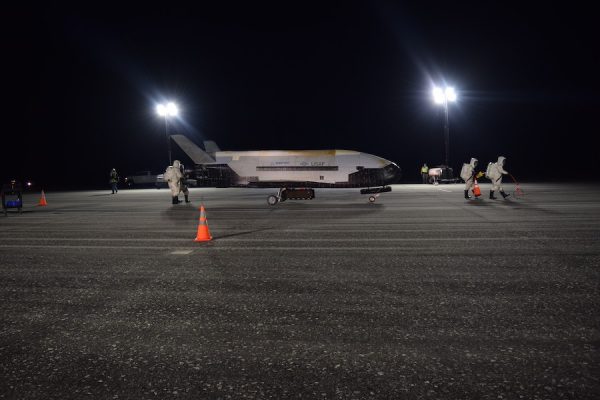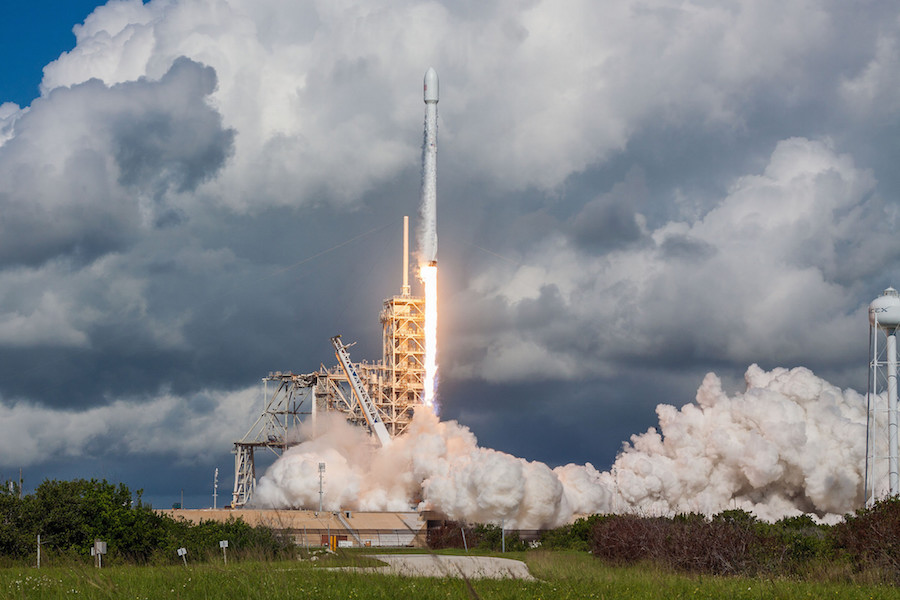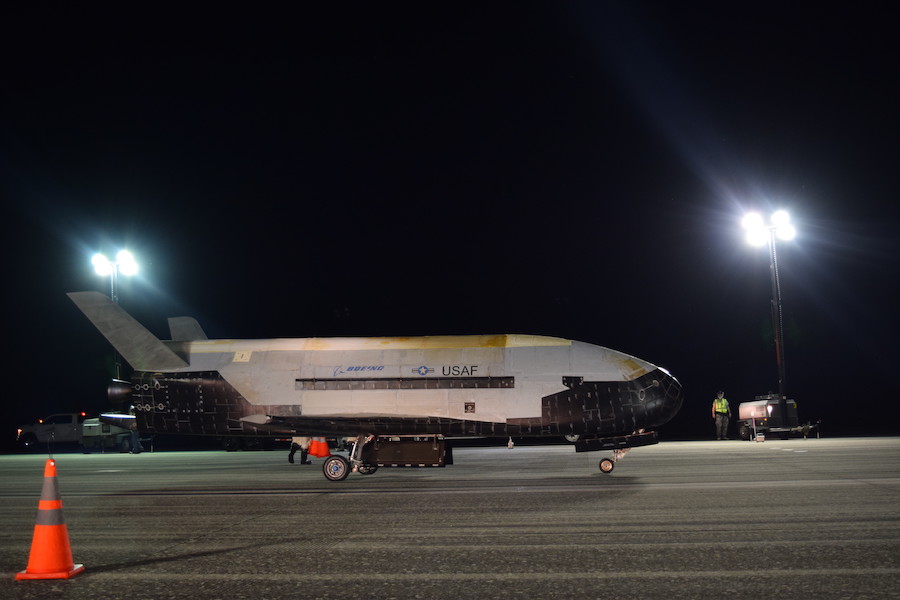US military’s X-37B spaceplane lands in Florida – Spaceflight Now – Spaceflight Now

The U.S. Air Force’s reusable Boeing-built X-37B spaceplane returned to Earth early Sunday with a touchdown at NASA’s Shuttle Landing Facility runway at the Kennedy Space Center in Florida, a few miles away from where it launched 780 days ago atop a SpaceX Falcon 9 rocket.
The unpiloted winged spaceplane, resembling a miniature space shuttle, touched down at the Florida spaceport at 3:51 a.m. EDT (0751 GMT) Sunday, the Air Force said in a press release.
“The X-37B continues to demonstrate the importance of a reusable spaceplane,” said Barbara Barrett, Secretary of the Air Force, in a statement. “Each successive mission advances our nation’s space capabilities.”
While the X-37B itself is not classified, details of its activities in orbit have remained largely secret. The spaceplane’s planned landing Sunday was also not disclosed in advance by the Air Force.
The X-37B landing Sunday completed the fifth — and longest — flight in the program’s history.
“The safe return of this spacecraft, after breaking its own endurance record, is the result of the innovative partnership between government and industry,” said Gen. David Goldfein, the Air Force chief of staff, in a statement.
The X-37B executed a ground-commanded deorbit burn early Sunday to target landing at the Kennedy Space Center, then performed a series of banking maneuvers during re-entry to dissipate speed before lining up with the shuttle-era runway near Cape Canaveral.
“With a successful landing today, the X-37B completed its longest flight to date and successfully completed all mission objectives,” said Randy Walden, director of the Air Force Rapid Capabilities Office, which manages the X-37B program. “This mission successfully hosted Air Force Research Laboratory experiments, among others, as well as providing a ride for small satellites.”

The reusable X-37B spaceplane, developed by Boeing Phantom Works, is designed to launch on top of a conventional rocket. Once in orbit, the craft opens its payload bay doors and extends a power-generating solar array, allowing it to remain in space for years.
NASA’s space shuttle was limited in mission duration to less than three weeks. NASA’s shuttle orbiter carried astronauts on every flight and used fuel cells consuming liquid hydrogen and liquid oxygen to produce electricity, and hydraulic actuators for its flight control surfaces, landing gear breaks and other components.
The X-37B — about one-fourth the length of NASA’s shuttle orbiters — uses electro-mechanical actuators, removing concerns about the limited useful of hydraulic control systems.
The Air Force says the X-37B “performs risk reduction, experimentation and concept of operations development for reusable space vehicle technologies.”
The fifth X-37B mission, which ended Sunday, launched Sept. 7, 2017, from launch pad 39A at Kennedy aboard a SpaceX Falcon 9 rocket. The four previous X-37B flights took off on United Launch Alliance Atlas 5 rockets from a nearby pad at Cape Canaveral.
The X-37B, also known as the Orbital Test Vehicle, has a wingspan of nearly 15 feet (4.5 meters) and a length of more than 29 feet (8.9 meters). The ship’s wings fit snugly inside the 17-foot-diameter (5-meter) payload shrouds on the Falcon 9 and Atlas 5 rockets.
“Today marks an incredibly exciting day for the 45th Space Wing,” said Brig. Gen. Doug Schiess, commander of the 45th Space Wing, which provides range safety support for launches and landings at Cape Canaveral. “Our team has been preparing for this event, and I am extremely proud to see their hard work and dedication culminate in today’s safe and successful landing of the X-37B.”
Boeing refurbishes the X-37B spaceplanes inside a former space shuttle hangar at the Kennedy Space Center. Ground teams were expected to roll the X-37B vehicle back to the hangar near Kennedy’s Vehicle Assembly Building later Sunday.

After its launch in September 2017, amateur satellite trackers found the X-37B in April 2018 in a circular 221-mile-high (356-kilometer) orbit inclined 54.5 degrees to the equator, a higher orbital inclination than the previous four X-37B missions. The higher inclination allows the spacecraft to fly over more parts of Earth on each trip around the planet.
Since then, the global community of satellite observers tracked the spaceplane as it changed altitude several times, finally maneuvering into a a low orbit with an average altitude of roughly 170 miles (274 kilometers) earlier this month. Previous X-37B missions had settled in a lower orbit in the weeks before landing.
One experiment that flew on the fifth X-37B mission was the Air Force Research Laboratory’s Advanced Structurally Embedded Thermal Spreader payload. The experiment was designed to to test electronics and oscillating heat pipe technologies for future satellite thermal control systems.
No other mission objectives were released by the Air Force, other than statements suggesting the X-37B mission provided a ride for other undisclosed small satellites.
Any small satellites that were deployed from the X-37B have not appeared in the U.S. military’s catalog of human-made space objects, and were not registered in accordance with the United Nations Registration Convention, according to experts who track space activity.
“Unless they mean the satellites were attached and not deployed, this is a violation of the UN convention,” wrote Jonathan McDowell, an astronomer at the Harvard-Smithsonian Center for Astrophysics who maintains an authoritative log of all global space launches.
The United States is one of 69 states that have ratified the UN Registration Convention, a list that also includes space powers such as China and Russia.
Ted Molczan, a leader in the global community of hobbyists who expertly monitor satellite movements, said the only two entries in the U.S. military’s catalog of human-made space objects attributed to the fifth X-37B mission were the spaceplane itself and its Falcon 9 upper stage. He added he was not aware of any sightings of satellites that may have been deployed by the X-37B.
If the X-37B released small satellites in orbit, it would be the first time that the United States or Russia have “blatantly flouted” the UN Registration Convention, McDowell tweeted.
“It is true that China and some other countries have not been fully compliant with the convention, but those cases did not involve deliberate withholding of information about secret military satellites,” McDowell wrote.
Boeing has manufactured two X-37B spaceplanes for the Air Force, and the next X-37B mission is scheduled to launch between April and June 2020 aboard an Atlas 5 rocket.
Here is a list of the X-37B missions to date:
Orbital Test Vehicle Mission 1
(first flight of Vehicle No. 1)
Launch: April 22, 2010, on Atlas 5 rocket
Landing: Dec. 3 2010, at Vandenberg Air Force Base, California
Duration: 224 days
Orbital Test Vehicle Mission 2
(first flight of Vehicle No. 2)
Launch: March 5, 2011, on Atlas 5 rocket
Landing: June 16, 2012, at Vandenberg Air Force Base, California
Duration: 469 days
Orbital Test Vehicle Mission 3
(second flight of Vehicle No. 1)
Launch: Dec. 11, 2012, on Atlas 5 rocket
Landing: Oct. 17, 2014, at Vandenberg Air Force Base, California
Duration: 675 days
Orbital Test Vehicle Mission 4
(unconfirmed which vehicle)
Launch: May 20, 2015, on Atlas 5 rocket
Landing: May 7, 2017, at Kennedy Space Center, Florida
Duration: 718 days
Orbital Test Vehicle Mission 5
(unconfirmed which vehicle)
Launch: Sept. 7, 2017, on Falcon 9 rocket
Landing: Oct. 27, 2019, at Kennedy Space Center, Florida
Duration: 780 days
Email the author.
Follow Stephen Clark on Twitter: @StephenClark1.






